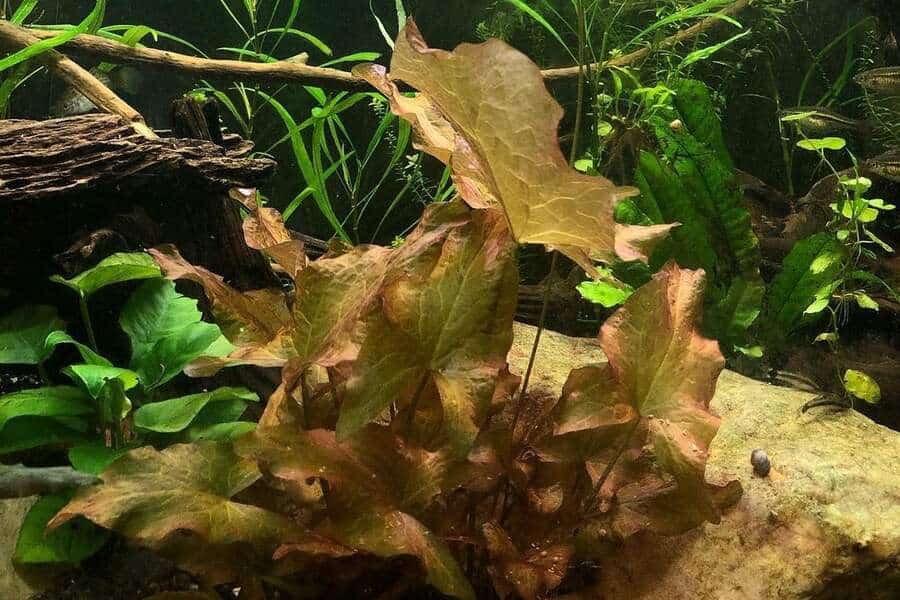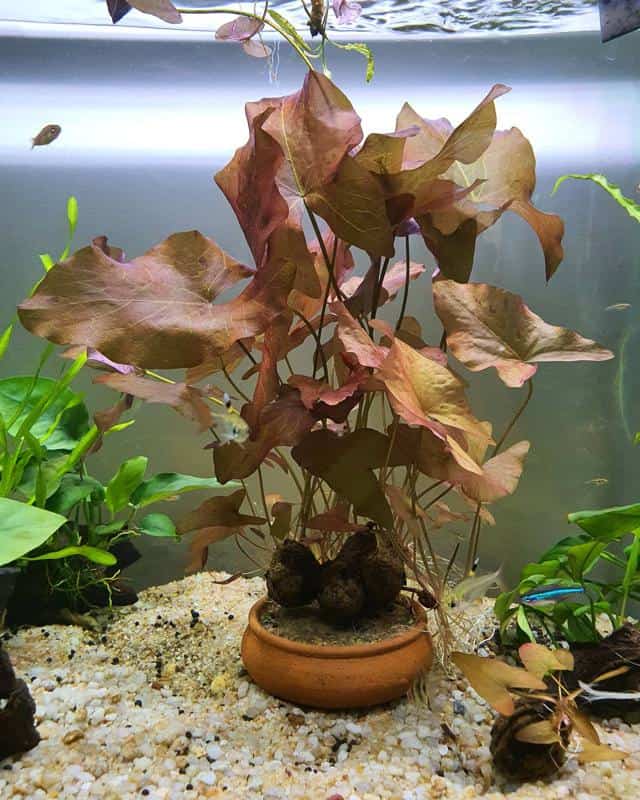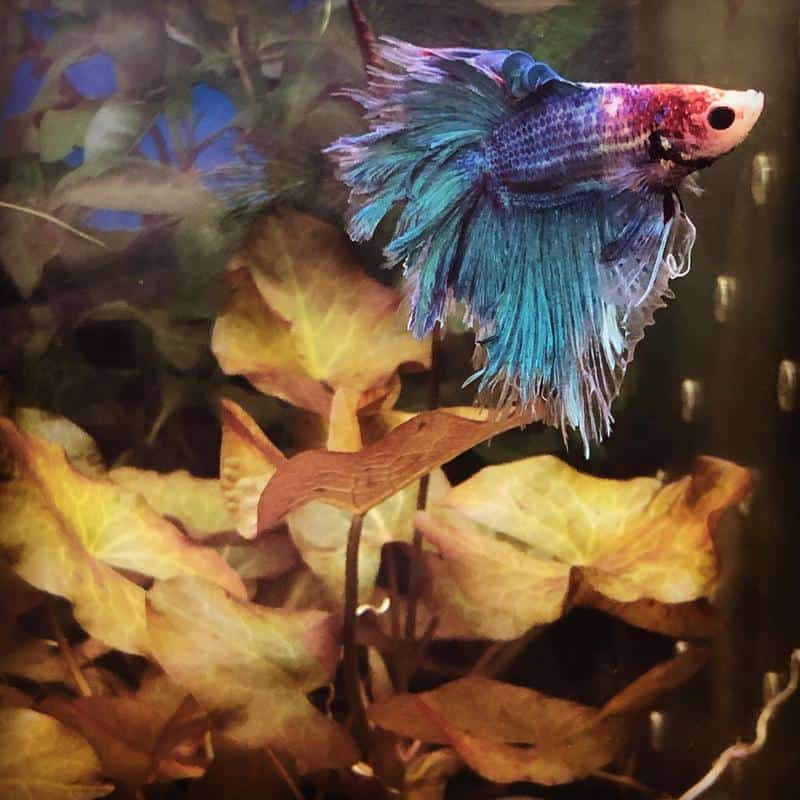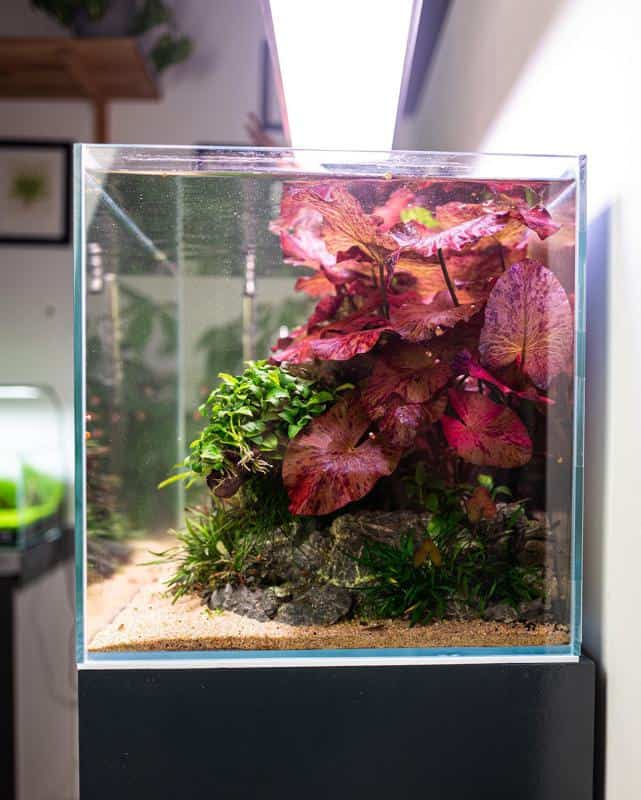The Dwarf Aquarium Lily (Nymphaea stellata) is a hardy, low-maintenance plant popular among new and experienced aquarium enthusiasts. With wide, vibrant green leaves, delicate flowers, and conspicuous colors, this stunning plant adds a touch of elegance to any aquarium.

Besides their visual appeal, dwarf aquarium lilies offer several benefits to any aquarium ecosystem. For example, these plants improve water quality and provide shelter and hiding spots for fish. But more on that later!
In this short guide, we will explore various interesting facts about dwarf aquarium lilies, including their origin, growth requirements, types, benefits, etc.
What Is a Dwarf Aquarium Lily?
The dwarf aquarium lily or dwarf water lily is a versatile aquatic plant native to the marshes and shallow ponds of Southeast Asia, India, and Australia. They are commonly used in home aquariums due to their striking beauty, benefits, and ease of care.
These aquarium plants belong to the Nymphaeaceae family and are scientifically described as Nymphaea stellata or Nymphaea nouchali. However, most people confuse them with the blue Egyptian lotus (Nymphaea caerulea).
Other names used to describe dwarf aquarium lilies include:
- Red dwarf aquarium lily
- Manel flower
- Dwarf red lily
Characteristics of Dwarf Aquarium Lily

Dwarf aquarium lilies often grow from a small bulb and can reach a maximum height of 5 inches, with each leaf growing to approximately 4 to 5 inches (if provided enough light).
The leaves are arguably the selling point of these plants. They assume an arrow shape or heart shape and come in several attractive colors, including:
- Red
- Pink
- Brown
- Green
Most times, it’s difficult to tell if the brown leaves are healthy or dying. For this reason, experts recommend trimming brown leaves. This will improve the plant’s appearance and allow only the brightest color to stand out in the water.
As for the flowers, dwarf aquatic lilies produce star-shaped flowers with red, white, blue, or yellow coloration. The flowers then give rise to the famous large lily pads the dwarf is famous for.
How to Plant Dwarf Aquarium Lily?
As highlighted above, Dwarf aquarium lilies grow from bulbs. These bulbs usually come packaged in peat moss for protection during shipping.
Once you’ve received your package, remove the bulb and rinse it in water to remove loose dirt. Next, place it on top of your tank’s substrate.
While some hobbyists recommend burying the bulbs in the substrate, we advise against them because they might rot. At first, the bulbs might float, but they will eventually absorb enough water and sink to the bottom.
After some time, the dwarf aquarium lily bulbs will sprout leaves. Burry a third of the leaves in the gravel or substrate to prevent fish in the tank or water current from moving the bulb. Eventually, the bulb’s root will extend into the ground, anchoring the dwarf water lily.
How to Propagate Dwarf Aquarium Lily?
After a few weeks or months in the tank, your dwarf aquarium lily will start producing several runners with small plantlets at their end. Chop off the offshoots or runners with scissors and plant them in different locations in your tank to give rise to new dwarf aquarium lilies.
How to Care for Dwarf Aquarium Lily?
Sure, the dwarf aquarium lily can adapt and survive in different environments. However, these plants require specific conditions to thrive in aquariums. Here, we will discuss the various dwarf aquarium lily requirements you must meet to ensure your plants survive in the tank.
Lighting Conditions
Unlike other aquarium plants, dwarf aquarium lilies are not very demanding. These plants can grow in low to medium light levels. But they prefer high light levels to produce more leaves and flowers.
However, if you can’t position the tank near an area that receives enough sunlight, you might want to get an artificial light. Place the light above the tank and keep it on for about 10 to 12 hours every day to boost the dwarf aquarium lilies’ growth.
Water Requirements
In an aquarium, Dwarf aquarium lilies prefer freshwater because salt water can dehydrate and kill them. They also thrive in neutral and slightly basic water with a pH of 6.0 to 7.5 and hardness of 2-15 dGH.
As for temperature, the plants will do better in conditions between 72 and 82°F, but they prefer 75°F. If the temperature drops past 72°F, the dwarf aquarium lily might enter a dormant state.
Maintaining proper water temperature is also important, since fluctuations might force the plant to enter a dormant state.
Nutrients Requirements
Like any other living thing, dwarf aquarium lilies require nutrients. These aquatic plants may need some fertilizer once in a while.
You can use liquid fertilizers to provide your water lilies with essential nutrients, like potassium and iron. Alternatively, you can opt for root tabs or other plant supplements to improve to plant’s health. Just avoid using too much fertilizer because this might lead to leaf burn and algae growth.
Maintenance
The dwarf aquarium lily is a fast-growing aquatic plant, and will easily fit in any space – as long as – it gets enough nutrients and sunlight. Because of this, the aquatic plant needs pruning or trimming regularly.
Chop large or damaged leaves, as well as stems using tweezers or scissors. If you like the lily pads and flowers submerged, you should remove those that reach the surface.
But keep in mind the floating lily pads might provide the fish shelter and hiding spaces.
Benefits of Dwarf Aquarium Lily in Aquariums

Dwarf aquarium lilies are low-maintenance, versatile plants that offer several practical benefits, including:
1. Providing Cover for Fish
The fish and invertebrates in the aquarium can convert the leaves, flowers, and lily pads of the dwarf aquarium lily into their homes.
Fish can hide in the shadow of the dwarf aquarium lilies when they feel threatened by other tank mates or stressed. In addition, the underside of the plants provides egg-lying fish, such as goldfish, a surface to lay their eggs.
2. Oxygenation of Water
Dwarf aquarium lilies help absorb CO2 in the water and release oxygen during photosynthesis. As a result, the water remains oxygenated and free from harmful substances. Another thing, it provides oxygen to the fish.
3. Improve Water Chemistry
Besides CO2 absorption, dwarf aquarium lilies remove excess nitrate, phosphate, and potassium from the tank. They also take up secondary nutrients like sulfur, magnesium, and calcium.
Excess nutrients in a tank trigger algae growth and can lead to bacterial buildup, causing harm to the fish. By keeping nutrients level down, dwarf aquarium lilies help reduce algae growth and toxins buildup, plus improve water chemistry. As a result, they help keep the fish tank clean and healthy.
4. Aesthetic Value
This small floating plant adds a sense of beauty and serenity to a tank. The dwarf aquarium lily’s attractive and colorful leaves and flowers provide a striking contrast to other aquatic plants. They also enhance the overall beauty of the fish tank.
Dwarf Aquarium Lily: Common Problems and Solutions
1. Dud Bulbs
Dud bulbs are bulbs that do not grow after planting. These bulbs usually feel soft and sometimes emit a foul smell.
In this case, check your water parameters, including pH, lighting, and temperature. If everything is fine, the bulb is the problem. Therefore, get a new dwarf aquarium lily bulb from a reputable aquatic plant supplier.
2. Fungal Infections
Many hybrids of dwarf aquatic lilies are resistant to diseases and pests. However, they might develop the following issues due to fungal infection:
- Leaf spot: Here, red or gray-brown spots might pop up on the leaves. The solution to this problem is to remove sick leaves.
- Crown rot: Dwarf aquarium lilies with this problem display yellow, curling leaves and rotting flower buds. You can handle this issue by disposing of the affected plant.
- Moldy plant: Dwarf aquarium lilies might appear moldy because it grows a natural biofilm layer. Worry not! The bio-film is safe for aquatic micro-organisms. But if the mold is white, then your plant has an infection. It’s best to address this problem immediately before your fish eats the infected area and dies. The best solution here is pruning the infected plant and treating it with a mix of antifungal treatment and aquarium salt.
3. Nutrient Deficiency
A dwarf aquarium lily requires nutrients to grow in an aquarium ecosystem. But if its leaves turn yellow or translucent, particularly at the tips, it’s a sign of nutrient deficiency.
This can be solved by adding aquatic soils rich in clay or peat moss or using liquid-based fertilizers. Organic fertilizers, like seaweed meals or shrimp meals, can also do the trick.
4. Overgrowth
Overgrown dwarf aquarium lilies need to be trimmed back before they grow too large. Also, clear dead and decaying leaves before they pollute the water. When pruning the overgrown parts of the plant, avoid damaging the delicate roots and leaves.
Dwarf Aquarium Lily Vs. Tiger Lotus

Dwarf aquarium lilies and tiger lotuses are the most popular aquatic plants used in home fish tanks. The plants share a lot of similarities with a few differences in appearance.
The Dwarf aquarium lily grows to a maximum of 5 inches and produces small, white, or red flowers and small lily pads. It also grows heart-shaped leaves from thin stems.
On the other hand, the tiger lotus is a robust plant that grows to 12 or 15 inches. Unlike dwarf aquarium lilies, this plant comes with large lily pads and flashy flowers with different shades. Also, the lotus has large round leaves.
Another difference is that tiger lotuses consume higher levels of nutrients and require more frequent fertilization than dwarf aquarium lilies.
Also Read:
Closing Thoughts
The dwarf aquarium lilies make great aquatic plants for aquariums of all sizes. They are versatile, hardy, and tolerant to low light conditions.
Furthermore, they provide many benefits to aquarium owners, including improving water chemistry and oxygen levels, and providing shelter for fish. Let’s not forget it adds beauty and interest to any fish tank.
To help your dwarf aquarium lily grow healthy, monitor the water quality regularly and provide it with nutrients (adding fertilizers). You should also protect it from fungal infection by adding a mixture of antifungal treatment and aquatic salt to the tank.
By doing this, this stunning plant will keep your fish healthy and tank clean for several years.
Do you need clarification on something? Inform us in the comment section!